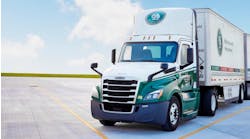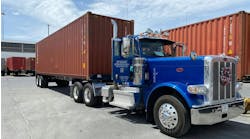While some fleets have a reputation for being among the first to embrace technological advances -- even testing them for vendors before the bugs are worked out -- they all agree that they aren't blinded by the glamour, the elegance, or even the sheer brilliance of the latest hardware or software. Their eyes are always on the bottom line.
"We don't buy some new technology just to be first," says Don Schneider, chief executive of Schneider National, Green Bay, Wis. "To us, technology is a tool that allows us to be more productive, but it's also an investment, and we recognize that every investment must be justified by cost."
Schneider has a reputation of trying new technologies before many other fleets have even heard about them. It's been a contributing factor to this truckload fleet's high efficiency and productivity.
According to Schneider, company officials continually monitor technological advances and review applications. "That's how we got into a relationship with Irwin Jacobs of Qualcomm."
When GPS applications first arrived on the scene, Schneider bought 15 units and tried them. The rest is history: The entire fleet was soon equipped with the Qualcomm units, and many other companies have followed suit. To Schneider, the idea of equipping trucks made sense economically, because it allowed deliveries to be made more efficiently. "It was clear that this technology added value. It was a worthwhile investment," says Schneider.
The attitude of Kevin Knight, chief executive officer of Knight Transportation, towards new technology is similar. "Buying new technology is a business decision. It has to make us a better company or we won't do it."
Phoenix-based Knight Transportation is a truckload carrier with 800 vehicles. Their interest in new technology often focuses on engine performance enhancements as opposed to in-cab technology.
According to Knight, he can't justify GPS because of its high cost, but he can justify almost every engine performance improvement that comes along. "New technology lets us move engine performance and fuel efficiency higher and higher. That's one of our main interests, because it goes right to our bottom line."
Knight notes that he relies on engine manufacturers to keep him abreast of the latest technology, and now he's looking at RF devices that allow terminals to check engine status and performance as they pass by.
"We need it to come at a fair price," he adds. "That's why we can't consider satellite systems for engine tracking. It's too expensive for us."
Besides using a specific technology to increase revenues, fleets think of technology as a way to leverage their unique competitive advantage. They rely on technology as a way to take what they do best and move it to an even higher level.
Officials at Roadway Express Inc. consider their sophisticated network as their most important asset, and it must be defended and strengthened.
"Our network is our main competitive advantage," says Dick Deardorff, vice president of maintenance and corporate services in Akron, Ohio. "We protect our core network and database with the latest technology and information management."
Roadway's network handles 60,000 shipments coming in and out of its terminals daily, in addition to handling 3,000 online users at one time. Data is available in real time through the RAPID system. According to Deardorff, the company's operations and planning department is responsible for keeping abreast of the latest technology, with three criteria always in mind. "If there is a cost benefit, efficiency benefit, or customer service benefit, we need to look at it."
Like others, Deardorff repeats the trucking industry's mantra about technology: "We can't have technology for technology's sake. It must have definite business value."
While technology is a way to make money, it's also often a way not to lose money. John Shehan, fleet manager, Chicago division of Pepsi-Cola General Bottlers Inc., says that he uses technology to focus on his priority: safety. "We want to do eight million accident-free miles every year. Accidents can be horrible, not only in human terms but in goodwill and money. No commercial vehicle operator wants to see his truck in the back of a school bus."
His interest in safety led him to study collision avoidance systems before most fleets had considered them. "I was skeptical at first, but in the past four or five years we haven't had one rear-end collision in a truck (with the system installed)." The fleet has installed 90 out of 225 trucks, with orders for another 30 units pending.
Shehan credits his college major, psychology, with helping him understand how technology devices work and how to customize them. With collision avoidance systems, when another vehicle is one second away from the bumper a loud beeper blasts and a light flashes. The driver hears the annoying beep and sees the light in his peripheral vision.
"The peripheral vision is where we, as humans, see threats," says Shehan. He adds that the beeper and the light are simple "adverse stimuli," and the driver reacts accordingly by slowing down to turn off the noise and lights and thus avoids the other vehicle. "It's a basic human instinct to want to reduce the noise."
Being on the forefront of technology has risks, of course, which these pathfinders minimize by justifying the up-front costs, keeping trials small, and adjusting their own mental attitude about what technology can reasonably accomplish. They understand their role of being technology proponents without going overboard. On the other hand, they relish a certain excitement in being among the first, and they're willing to accept the consequences.
"Somebody has to make progress," says Shehan. "I'm paid to keep my eyes on the horizon -- and over the horizon." He notes that Pepsi-Cola allows him to take some calculated risks and to act like an entrepreneur. "You have to realize that pioneers get a lot of arrows in their backs. You have to accept that."
Shehan says that many people don't like to make decisions or take risks, which inhibits them from taking advantage of the latest technological advances. "Not being willing to make a mistake is a mistake in itself."
These pioneers also learn from their mistakes. Schneider remembers when his company tried a positioning system known as Pegasus, which was a military spin-off. In the Pegasus system, radio signals were bounced off of meteor trails that are present throughout the ionosphere. Schneider says that although the system was cheaper than a satellite-based system, it wasn't reliable. "Periodically it wouldn't work," he says, suggesting that perhaps there weren't enough meteors to bounce the signals.
This experience taught Schneider an important lesson about people and new technology. "Our people saw it as a support item they could use once in a while. They didn't trust the technology, so they ended up going back to their old way of doing things." The lesson: Technology must work as expected for people to trust and use it.
Another danger in being one of the first to test new technology is the so-called "Hawthorne effect," in which the experimenter's desire for a positive outcome can actually contribute to one. The simple act of wanting something to work, and perhaps unconsciously contributing to its success can often influence results.
Although first noticed during psychological testing, this phenomenon may also be present when new applications of technology are tested because of the human component. "Does a certain technology work in day-to-day operation once all the attention (of the experiment) is over? " asks Schneider. "It's something we have to be careful about."
Deardorff credits a change in how his fleet now thinks about information with their interest in trying new technologies. He says the fleet realized that it moves information as much as it moves freight. This change in mind-set not only allows employees to feel comfortable with new information technology, but also allows them to think about how they can apply new technology to the entire fleet.
"Our people are computer literate," says Schneider. "They're used to technology and aren't afraid of it." The flip side is also true. Companies with people who aren't computer literate or who are afraid of change don't use the technology from which they could reap so much benefit.
But there's another stumbling block to using the latest technology. It has to do with investment -- not in equipment, but in people. Because new technology can be a huge investment in and of itself, many companies are loath to take on further financial burdens by hiring high-salaried people to operate and maintain that technology. This is especially true in hiring people to do research and analysis. "Many companies don't want to take on the highly skilled people needed. It's a lot of overhead," says Schneider.
When it comes to the human side of taking on new technology, Shehan notes one unexpected paradox, and it worries him for the long term. While technology may require a higher level of employee skill, it can sometimes be used to compensate for poor job skills, especially among entry-level workers. This could result in a work force with fewer and fewer job skills.
As an example, Shehan points to automated manual transmissions, which are used to shorten training time. "Are we throwing technology at a competency problem? " he asks.
"Yes," he says reluctantly, "but it works."


